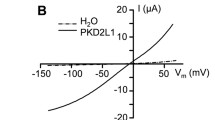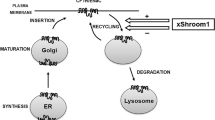Abstract
The aim of this study was to examine the question of whether activation of wt-CFTR (wild-type cystic fibrosis transmembrane conductance regulator) by cAMP and the opening of a Cl–conductance is paralleled by exocytosis and corresponding increases in membrane capacitance. To this end three types of Chinese hamster ovary (CHO) cells were examined: a control group of CHO cells; a group of CHO cells stably expressing wt-CFTR at high levels (also called BQ2-CHO); and a group of CHO cells stably expressing the frequent mutation ΔF508-CFTR. Whole-cell patch-clamp studies were performed to measure the membrane voltage (V m), the membrane conductance (G m) and the membrane capacitance (C m). C m was assessed by a two-frequency lock-in amplifier method. Forskolin (Fsk, 0.1 μmol/l) and isobutylmethylxanthine (IBMX, 0.1 mmol/l) were used to increase cytosolic cAMP. It is shown that Fsk and IBMX had no effect on V m and G m in control CHO and ΔF508-CFTR-CHO cells. Fsk and IBMX depolarized wt-CFTR-expressing CHO cells significantly (from –40 ± 1.5 to –32 ± 1.6 mV, n = 41) and enhanced G m strongly from 5.0 ± 0.9 to 36 ± 3.9 nS (n = 65). The conductance increase was mostly for Cl–, because under stimulated conditions a reduction in bath Cl–concentration depolarized these cells further and significantly from –26 ± 1.8 to –10 ± 1.2 mV (n = 16). This conductance had the characteristic wt-CFTR selectivity of Br– > Cl– > I–(n = 16). Despite this large increase in the Fsk- and IBMX-induced conductance C m was not altered significantly (15.5 versus 15.7 pF, n = 50). These data indicate that stable overexpression of wt-CFTR but not of ΔF508-CFTR in CHO cells induces a cAMP-activated Cl–conductance. The activation of this large conductance obviously proceeds with little if any exocytosis.
Similar content being viewed by others
Author information
Authors and Affiliations
Additional information
Received: 13 May 1997 / Received after revision: 1 July 1997 / Accepted: 7 July 1997
Rights and permissions
About this article
Cite this article
Hug, M., Thiele, I. & Greger, R. The role of exocytosis in the activation of the chloride conductance in Chinese hamster ovary cells (CHO) stably expressing CFTR. Pflügers Arch 434, 779–784 (1997). https://doi.org/10.1007/s004240050465
Issue Date:
DOI: https://doi.org/10.1007/s004240050465




